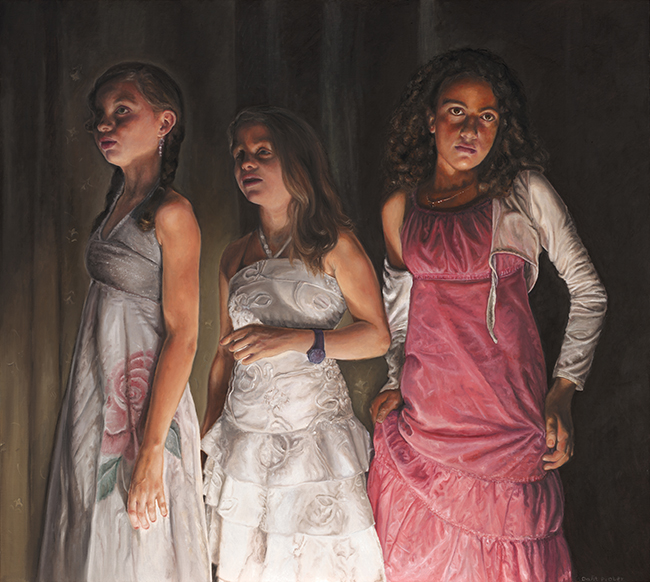דלית פרוטר — נשים קטנות
חמישי, 10.10.13 | שעה 20:00

אודות התערוכה
חלומות, היסוס, סקרנות, עור צח, כוח עלומים, רעננות, העמדת פנים, שליטה עצמית, פיתוי, תום, שמחה, בהלה, גוזיות ורודות ושעוני פלסטיק, שמלות הדורות, רצינות תהומית ומבטי קונדס, ייאוש וגדלות רוח, הם מסימני ההתבגרות אותם לוכדת בעזות דלית פרוטר בסדרת הדיוקנאות נשים קטנות.
פרוטר מביימת את בתה וחברותיה המֶלוּבַּשוֹת בבגדי “הבת מצווה” שלהן בתנוחות שונות בחדר חשוך עם שטיח, בתאורה קיצונית כדי לספר סיפור. הבנות, ביחד ולחוד, מגלמות את עצמן לכודות בין שני העולמות – הילדותי והבוגר. בניגוד לרמברנדט – הבוחר להאיר את הבעות הפנים ולהצליל את הסביבה – מיטיבה פרוטר לתאר את הקונפליקט בכיוון הזרקור דווקא אל הפרטים המצויצים בשמלותיהן ההדורות מדי, בהשאירה את מבטיהן הילדותיים התוהים-נוצצים בחשיכה, בכך יוצרת ניגודיות מבריקה בין הנשי העמוס לעייפה וחופש ההבעה הילדותי. פרוטר מגלה הבנה עמוקה בנפש הבנות העומדות לפניה ומעתיקה אותה אל הבד בווירטואוזיות נוגעת ללב, כשהיא שולטת בהבעות פניהן ובתנוחותיהן המכילות את המשברים והתקווה, כמו מנחשת את הבאות. את שיאה של תובנתה ניתן לראות בציור הריקוד של האם ובתה בו נראים השמחה, האהבה והקשר בין האישה לילדה-נערה אבל גם הקושי, הדאגה, חוסר השליטה והנתק הטבעי שעומד להתרחש.
הטכניקה עוזרת לפרוטר לספר את הסיפור. השימוש בצבע השמן מאפשר לה לרבד את הסצנה בשכבות על מנת לדייק את קמטי הבד, השיער והמבט. הדמויות גדולות הממדים, המגלות את אופיין בתנוחה, במבט ובבחירת הבגד, פרושות על פני כל הבד ואין ספק לגבי מעמדן כגיבורות. על אף שמבחינה פורמלית הציורים פיגורטיביים וריאליסטים, הם לא נאמנים למקור. פרוטר יוצרת מניפולציות כי אין בכוונתה להעתיק אלא להביע ועל כן, היא מעצבת מחדש את הקומפוזיציה והמציאות, מתקנת ללא היסוס את הצבע, מבהירה ומחשיכה את הפנים על מנת לדייק ולחדד את תחושותיה ואת הדרמה הקורית על הבד.
בחיים, הגלגול אל הנשיות נמשך שנים, אבל בסדרה נראה שהילדות עוברות את השינוי תוך כדי התבוננותנו בציור כמין צמיחה מואצת, כמו שתיאר הרמב”ם:”בת שתיים עשרה שנה ויום אחד… הלא הן גדולות לכל המצוות”.
נעילת התערוכה: 11.11.13
Dalit Proter — Little Women
Thursday 10.10.13 | at 20:00
Proter directs her daughter and friends, dressed in their Bat-Mitzvah gowns, in a variety of poses in a dark room with a carpet, in extreme lighting, to tell a story. The girls, individually and in groups, portray themselves trapped between two realms: childish and mature. Contrary to Rembrandt who chooses to illuminate the facial expressions while casting shadows on the rest, Proter excels at describing the conflict by focusing the projector on the frilled details in their extravagant dresses, leaving their naïve childish looks in the dark, thus creating a brilliant contrast between the excessive-overloaded femininity and the childish-expressive spontaneity. Proter manifests a profound grasp of the spirit of the girls facing her and transfers it to the canvas in moving virtuosity, controlling their expressions and postures encapsulating the crises and hope, as if foreseeing the future. The climax of her insight is visible in the mother-daughter dance painting where happiness, love and mother-girl/woman attachment are visible alongside the difficulty, anxiety, lack of control and looming natural separation.
The technique helps Proter tell the story. Oil paint enables the layering of the scene to accurately convey the fabric-creases, hair and stare. The sizeable figures expose their personality in posture, expression and selection of clothes, are spread all over the canvas, leaving no doubt about their heroic status. The paintings, even though formally figurative and realistic, are not accurate renderings of the original. Proter creates manipulations because she does not wish to copy but rather convey. She therefore redesigns the composition and reality, confidently controlling colors, lightening and darkening the face to crystallise and sharpen her feelings and the drama occurring on the canvas.
In real-life, the metamorphosis into femininity lasts for years, but in this series it seems that the girls undergo the change as we watch the painting in some accelerated growth as portrayed by Maimonides: “Twelve years old and one day…they are mature for all obligations”.
Closing: 11.11.13
